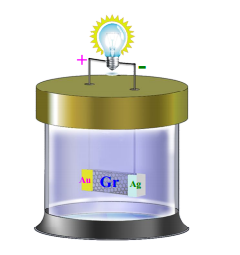
Graphene Battery Turns Ambient Heat Into Electric Current – Technology Review
Physicists have built a graphene battery that harvests energy from the thermal movement of ions in solution
Here's an interesting idea for a battery. The thermal velocity of ions in aqueous solution is huge–hundreds of metres per second at room temperature. And yet few people have studied this process or its potential to generate current.
Step forward Zihan Xu at The Hong Kong Polytechnic University and a few buddies who have not only studied this process but seemingly mastered it too.
 These guys have created a circuit consisting of an LED connected to a strip of graphene by some wire. They simply placed the graphene in a solution of copper chloride and watched. Sure enough, the LED lights up. (Actually, they needed six of these graphene circuits in series to generate the 2V needed to make the LED light up but you get the picture.)
These guys have created a circuit consisting of an LED connected to a strip of graphene by some wire. They simply placed the graphene in a solution of copper chloride and watched. Sure enough, the LED lights up. (Actually, they needed six of these graphene circuits in series to generate the 2V needed to make the LED light up but you get the picture.)
Here's what's going on, according to Zihan and co. The copper ions, which have a double positive charge, move through the solution at a rate of about 300 metres per second thanks to the thermal energy of the solution at room temperature.
When an ion smashes into the graphene strip, the collision generates enough energy to kick a delocalised electron out of the graphene.
The electron then has two options: it can either leave the graphene strip and combine with the copper ion or it can travel through the graphene strip and into the circuit.
It turns out that the mobility of electrons is much higher in graphene than it is through the solution, so the electron naturally chooses the route through the circuit. It is this that lights up the LED.
“The released electrons prefer to travel across the graphene surface…instead of going into the electrolyte solution. That is how the voltage was produced by our device,” say Zihan and co.
So the energy generated by this device comes from ambient heat. These guys say there were able to increase the current by heating the solution and also by accelerating the copper ions with ultrasound. They even claim to have kept their graphene battery running for 20 days on nothing but ambient heat.
Phi Beta Iota: There is no lack of free to low-cost energy solutions. Up to this point industry, in collusion with Congress, has been able to keep such “meter-killers” off the marketplace. What is new now is a combination of the advancement of non-US science in Brazil, China, India, and Russia, and the Internet. We anticipate a new movement of new small cities that are committed to being “off the grid” from day one.



